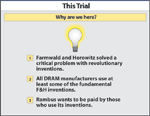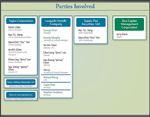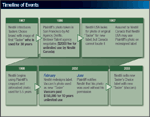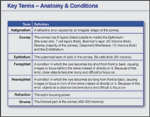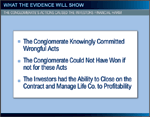|
|
|
|
|
|
|
|
|
|
|
ArticlesYou Only Get One Chance To Make A Great First ImpressionUse visual tools to make a powerful Opening Statement. After voir dire, jurors generally have only a vague notion of what your case is about. More importantly, no matter how successful you were in using your challenges, some jurors will have their own subtle biases, distorted views, and misperceptions of the law applicable to your case. But if your jurors have open minds, then Opening Statement is your first opportunity to begin persuading them. How can you make the most of it? In a succinct yet comprehensive Opening Statement, you must begin to teach the jury all of the following elements:
Successful teaching requires that the information be both understood and retained by the recipient. A study by the Rand Corporation found the following rates for understanding and retention of information over a 24-hour period:
Thus, because most people are visual learners, the use of visual tools to convey information greatly enhances both understanding and retention of that information. Moreover, information presented visually is more persuasive than the same information presented non-visually. In a landmark 1986 study at the University of Minnesota, researchers concluded: Perceptions of the presenter as well as audience attention, comprehension, yielding, and retention are enhanced when presentation support is used compared to when it is not. Presentations using visual aids were found to be 43% more persuasive than unaided presentations. Therefore, to make the most of your only chance to make a first impression, visual tools are essential. Here are some tips for using graphics to teach each of the five elements of an effective Opening Statement listed above. What is the Theme?
Who are the Key Players?
In some cases, a simple chart listing the names and positions of the actors in this drama will suffice. However, in some circumstances you may wish to "humanize" your client. For example, if you are defending a large corporation, you will want jurors to see your client as a collection of human beings rather than as an impersonal entity. This might be accomplished by showing photographs next to each name and position. On the other hand, if you are opposing a large corporation, a well-designed graphic could show the sheer size of that Goliath, using revenues or other factual data. Thus, visuals should be used in Opening Statement not only to introduce the players to the jury, but also to strategically define the parties to your advantage in a memorable way. What Happened?
At this early stage, you want jurors to see the big picture. Pick out a handful of benchmark events from your master timeline and create an overview chronology for Opening Statement. Having first presented a concise theme, and then introduced and defined the parties, you can now show the jury what transpired. At this point, you will have made a visual presentation of your essential story that average jurors can understand and remember. And, like the other demonstrative exhibits that you employ in Opening Statement, your overview chronology can be used in closing argument, when it is time to summarize your case, tie it all together, and move the jurors to your desired result. What are the Key Terms?
During Opening Statement, use demonstrative exhibits as teaching tools to start your jurors' technical education. If there are terms with which the average juror may not be familiar, present a chart listing those terms and their definitions. If there is a concept that will be difficult to comprehend, show the jury an analogy relating that idea to something familiar. If there is a process that is obscure to the common person, display a basic tutorial on the subject during Opening Statement. Later, your experts will continue this educational effort – preferably with visual aids that build upon the exhibits you introduced in Opening Statement. What Evidence Will the Jurors See?
To achieve maximum comprehension and retention, visual tools are essential. If there is a smoking gun, such as a critical sentence in an email or other document, display it. Use a document call-out (a picture of the document, with the key lines highlighted and magnified in large type next to the document) to make this item stick in the jurors' minds. If a highly persuasive element of your case is an item at the scene of an event, present the jurors with a blown-up picture so they can actually see it. Never just tell, when you can show and tell. Use Visual Tools to Make a Powerful Opening Statement Opening Statement is your only chance to make a great first impression with jurors. To make the most of this opportunity, teach the jury the five essential elements listed above using effective graphics to increase understanding and retention.
Ralph Mongeluzo is Director of Litigation Services at Think Twice, Inc., a nationwide courtroom graphics and presentation firm. Contact Ralph at ralph@thinktwicelegal.com or (415) 834-2000. |
|
Obiter Dictum
|
|
